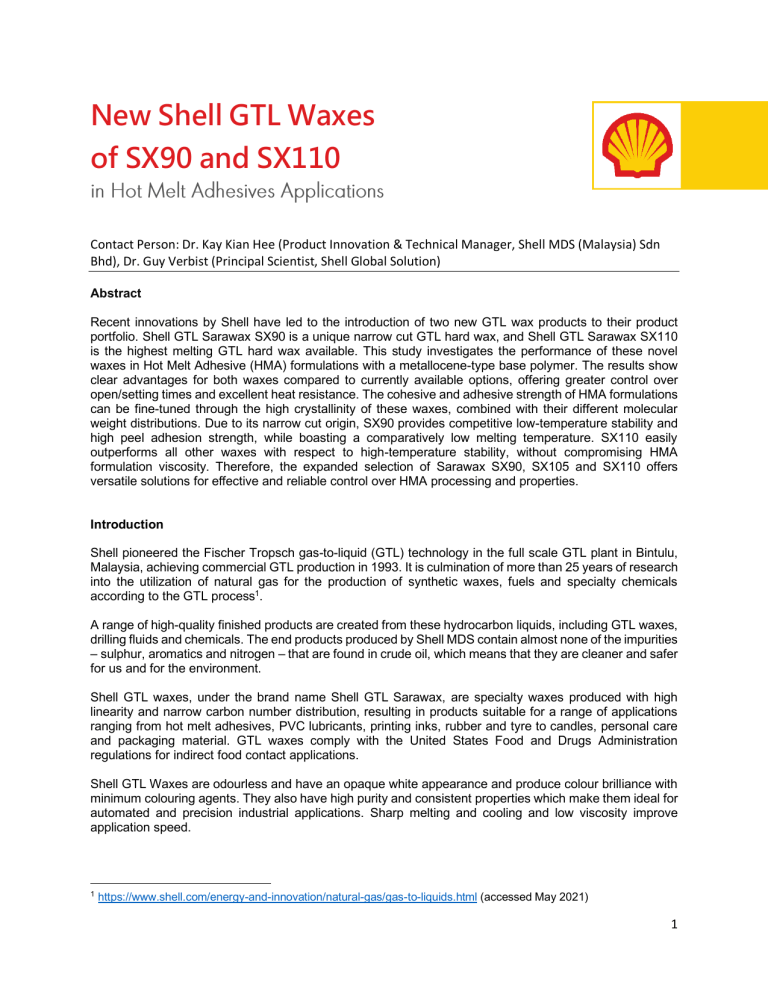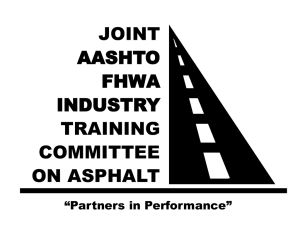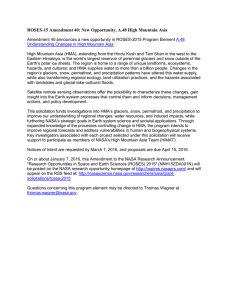
New Shell GTL Waxes of SX90 and SX110 Contact Person: Dr. Kay Kian Hee (Product Innovation & Technical Manager, Shell MDS (Malaysia) Sdn Bhd), Dr. Guy Verbist (Principal Scientist, Shell Global Solution) Abstract Recent innovations by Shell have led to the introduction of two new GTL wax products to their product portfolio. Shell GTL Sarawax SX90 is a unique narrow cut GTL hard wax, and Shell GTL Sarawax SX110 is the highest melting GTL hard wax available. This study investigates the performance of these novel waxes in Hot Melt Adhesive (HMA) formulations with a metallocene-type base polymer. The results show clear advantages for both waxes compared to currently available options, offering greater control over open/setting times and excellent heat resistance. The cohesive and adhesive strength of HMA formulations can be fine-tuned through the high crystallinity of these waxes, combined with their different molecular weight distributions. Due to its narrow cut origin, SX90 provides competitive low-temperature stability and high peel adhesion strength, while boasting a comparatively low melting temperature. SX110 easily outperforms all other waxes with respect to high-temperature stability, without compromising HMA formulation viscosity. Therefore, the expanded selection of Sarawax SX90, SX105 and SX110 offers versatile solutions for effective and reliable control over HMA processing and properties. Introduction Shell pioneered the Fischer Tropsch gas-to-liquid (GTL) technology in the full scale GTL plant in Bintulu, Malaysia, achieving commercial GTL production in 1993. It is culmination of more than 25 years of research into the utilization of natural gas for the production of synthetic waxes, fuels and specialty chemicals according to the GTL process1. A range of high-quality finished products are created from these hydrocarbon liquids, including GTL waxes, drilling fluids and chemicals. The end products produced by Shell MDS contain almost none of the impurities – sulphur, aromatics and nitrogen – that are found in crude oil, which means that they are cleaner and safer for us and for the environment. Shell GTL waxes, under the brand name Shell GTL Sarawax, are specialty waxes produced with high linearity and narrow carbon number distribution, resulting in products suitable for a range of applications ranging from hot melt adhesives, PVC lubricants, printing inks, rubber and tyre to candles, personal care and packaging material. GTL waxes comply with the United States Food and Drugs Administration regulations for indirect food contact applications. Shell GTL Waxes are odourless and have an opaque white appearance and produce colour brilliance with minimum colouring agents. They also have high purity and consistent properties which make them ideal for automated and precision industrial applications. Sharp melting and cooling and low viscosity improve application speed. 1 https://www.shell.com/energy-and-innovation/natural-gas/gas-to-liquids.html (accessed May 2021) 1 As a company that embraces innovation, Shell is always excited to share the innovative stories and new product applications with industry and customers. Therefore, Shell would like to introduce new wax products to the product portfolio. Shell GTL Sarawax SX90, the unique narrow cut GTL hard wax, and Sarawax SX110, the highest melting GTL hard wax, are now established for use with metallocene polymer, in hot melt adhesive formulations. Hot Melt Adhesives Hot Melt Adhesives (HMAs) have numerous advantages over the solvent-based adhesives. The lack of solvent in HMAs leads to dramatic decrease in volatile components during application. Moreover, since the adhesive material does not have to be dissolved in a solvent, redundant transportation costs or storage problems are prevented. However, HMAs are also known with some inherent limitations. They are sensitive to temperature; softening and failure takes place at elevated temperatures and at low temperatures HMA becomes brittle. HMA formulations are based on three main components named as base polymer, wax and tackifier. In general, the base polymer increases the viscosity during application and provides cohesive strength to the adhesive while the tackifier improves tacking to the substrate. The wax is used to control formulation viscosity (during processing and upon application), provide heat resistance to the HMA, and to regulate open time and setting time. The type of each component as well as their relative amounts in the formulations can significantly influence the HMA properties and the application area of the adhesive. Generally, the wax can take up to 1/3rd of the total HMA formulation. Various types of waxes can be considered for HMA application 2,3. However, GTL waxes stand out due to their highly linear structure, meaning, rapid crystallization, high crystallinity and low melt viscosity. Furthermore, GTL waxes exhibit good compatibility with polyolefins and/or EVA, which are commonly used base polymers in HMAs4. Compared to more conventional PE waxes, the benefit of the lower viscosity of GTL waxes is readily apparent. However, within the field of GTL waxes, subtle differences in properties can also significantly affect HMA properties and performance. This study aims to highlight this by comparing currently applied GTL waxes with the newly developed SX90 and SX110 waxes. Materials and Methods The performance of the new GTL Sarawax SX90 and SX110 products in HMA formulations was investigated. For comparison purposes, SX105 was included in this work, as well as FT1, a commercially available GTL wax which is applied in HMA formulations. The other components used in the HMA formulations were as follows: - Base polymer: Affinity GA 1950 - a polyolefin plastomer, Tm ~76 °C - Tackifier: Eastotac H115-R - an aliphatic hydrocarbon resin, softening point 115 °C, Tg ~63 °C - Stabilizer: Irganox 1010 - a commonly used anti-oxidant in plastic industry HMA formulations with two different compositions were prepared. In order to see the effect of the wax clearly, the ratio between the base polymer and the tackifier was kept constant at 1:1 in all blends. Formulations with base polymer, tackifier and wax were prepared in a ratio of 45-45-10 and 33-33-33 wt%. 0.5 wt% of anti-oxidant was added to the formulations as stabilizer. Sample preparation and analysis methods are detailed in the Experimental Appendix. 2 D. Robertson et al., International Journal of Adhesion and Adhesives, 99 (2020) 102559 J. B. Kalish et al., International Journal of Adhesion and Adhesives, 60 (2015), pp. 63–68 4 Y-J. Park et al., J. Adhesion Sci. Technol., 20 (2006), No. 14, pp. 1561–1571 3 2 Results – SX90 & SX110 DSC thermograms of the tested waxes are shown in Figure 1. It is clear that SX90 and SX110 have sharp melting and crystallization transitions, reflecting effective control over the production process which results in sharp and well-defined cuts. Further properties of these waxes are listed in Table 1. 0.0 SX90 SX105 SX110 FT1 Heat flow (W/g) 1.0 -0.5 Heat flow (W/g) 1.2 0.8 0.6 0.4 -1.0 -1.5 -2.0 SX90 SX105 SX110 FT1 0.2 -2.5 0.0 20 40 60 80 100 120 20 Temperature (°C) 40 60 80 100 120 Temperature (°C) Figure 1. DSC thermograms of the tested waxes, heating and cooling curves (left and right plots, respectively). Table 1. Properties of linear GTL-waxes. Wax Drop melting point (°C) Congealing point (°C) Crystallinity (%) Kinematic viscosity, 130 °C (mm2/s) SX90 96 94 79 9.6 SX105 117 106 78 15.7 SX110 118 111 86 36.3 FT1 110 101 81 13.4 Results – HMA properties An overview of the obtained HMA properties is shown in Tables 2 and 3. The measured melting and crystallization onset temperatures of the HMA formulations are in accordance with the data of the pure waxes. When the wax content in the HMA is higher, these values are closer to that of the pure wax, as can be expected. Similarly, for HMA formulations with a higher wax content, a slightly higher Tg is found. This indicates that these are less flexible materials, which is easily understood given the increased content of a hard wax. However, the type of wax does not influence Tg significantly. The availability of SX90 and SX110 provides greater control over the thermal properties of HMA formulations, while not significantly affecting their Tg or viscosity compared to currently used waxes. 3 Table 2. Properties of HMA formulations containing 10 wt% wax. Open Setting Tmelt Tc, onset Tg Viscosity Wax time time (°C) (°C) (°C) (Pa.s) (s) (s) Setting temperature (°C) SAFT (°C) PAFT (°C) Cold crack temperature (°C) SX90 89 83 -21 17 17 55 71 77 70 -25 SX105 106 97 -24 16 12 36 80 77 73 -25 SX110 108 100 -23 18 11 35 95 95 80 -25 FT1 100 90 -23 17 15 46 72 78 73 -25 Setting temperature (°C) SAFT (°C) PAFT (°C) Cold crack temperature (°C) Table 3. Properties of HMA formulations containing 33 wt% wax. Open Setting Tmelt Tc, onset Tg Viscosity Wax time time (°C) (°C) (°C) (Pa.s) (s) (s) SX90 94 90 -16 3 15 31 87 89 64 -15 SX105 113 103 -18 3 11 30 101 103 71 ≥ -10 SX110 113 106 -18 4 10 20 105 110 71 ≥ -10 FT1 107 97 -19 3 12 32 94 94 63 -15 Open time, setting time and setting temperature Figure 2 shows the open time, setting time and setting temperature of HMA formulations containing 33 wt% wax. Open time indicates how long it takes for the molten HMA to cool down to a state when it starts to solidify and thus can no longer bind well to the substrates. Setting time indicates the time it requires for the molten HMA to set upon cooling, i.e. to form strong bonds with the substrates. Setting temperature indicates the temperature at which the HMA forms a sufficiently cohesive structure. These three parameters are all related to the process of solidification of HMA, which mainly is controlled by the wax crystallization process. From Figure 2 it can be seen that HMAs containing higher crystallization point waxes also have a higher setting temperature, and shorter open/setting times. An example of the effect of the crystallization behavior of the waxes on the setting process of the HMAs is shown in Figure 3, where the correlation between the HMA setting temperature and the crystallization peak temperature is clearly visible. It can be concluded that SX90 and SX110 expand the possibilities for careful control over the HMA setting process, offering additional flexibility to tune the HMA application process via adjusting the open/setting times and setting temperature. 4 16 35 14 30 25 Setting time (s) Open time (s) 12 Setting temperature (oC) 100 10 8 6 20 15 10 4 5 2 SX90 SX105 SX110 SX90 FT1 60 40 20 0 0 0 80 SX105 SX110 FT1 SX90 SX105 SX110 FT1 Figure 2. Open time (left), setting time (middle) and setting temperature (right) of HMA formulations with 33 wt% wax. 110 Setting temperature (°C) 105 100 95 90 85 80 75 70 80 85 90 95 100 105 Crystallization peak temperature (°C) Figure 3. Correlation between crystallization peak temperature and the setting temperature of the HMA formulations. Heat resistance to adhesion failure (SAFT & PAFT) The shear adhesion failure temperature (SAFT) and peel adhesion failure temperature (PAFT) values of the HMA formulations are plotted together in Figure 4. SX110 formulations clearly show the highest heat resistance to adhesion failure, reflecting its high melting and crystallization temperatures. SX90, despite its lower melting point, shows very comparable performance to the high-melting FT1 wax. This superior performance is attributed mostly to the sharp melting trajectory of the SX90. Furthermore, it seems somewhat curious that a higher amount of wax leads to decreased PAFT values, particularly since the opposite is observed for the SAFT values. It is hypothesized that the initial onset of the melting of the wax already causes some de-bonding of the Y-joint, which is amplified as the Y-joint is progressively peeled apart. This de-bonding amplification effect may then be more pronounced when more wax is present in an HMA formulation, leading to failure at lower temperatures. 5 120 SAFT PAFT Temperature (°C) 100 80 60 40 20 0 SX90 SX105 SX110 FT1 SX90 SX105 SX110 FT1 10 % 33 % Figure 4. SAFT and PAFT of the HMA formulations. Adhesion strength Shear and peel adhesion strength testing was performed for all HMA formulations. During the testing of the shear strength all of the tested specimens showed breakage of the Kraft paper substrate after the same amount of stress. This indicates that the HMA bonding was sufficiently strong for all waxes. Maximum peel force (N) Figure 5 shows the maximum force required to peel off the substrate from the HMA adhesive for all formulations. It can be seen that SX90 outperformed the other waxes in terms of providing the highest peel adhesion strength to the HMA. This higher resistance to peeling could be related to the higher elasticity of the SX90 due to the shorter (and more flexible) chains of the wax molecules. It could also be related to the longer open times of the formulations with SX90 (as seen from Figure 2), where the longer time available to bond to the substrate could be beneficial for better peel adhesion strength. 10 5 0 SX90 SX105 SX110 FT1 SX90 SX105 SX110 FT1 10 % 33 % Figure 5. Maximum peel force of the HMA formulations. 6 Low-temperature stability The low-temperature performance of the HMA formulations was evaluated by cold crack testing. The results are listed in Tables 2 and 3. At low wax loadings all HMA formulations show equal performance, however at high wax loading it was found that SX90 performs as well as FT1. Furthermore, SX90 also outperforms SX105 and SX110 in low-temperature conditions. The stability of the HMA formulations at low temperatures can also be asses by looking at the ratio between the loss modulus (E”) and the storage modulus (E’), the quantity tan = E”/E’, which is commonly used to reflect a material’s behavior to be more elastic (tan < 1) or more viscous (tan > 1). The tan value is related to the cohesive strength of the material – lower tan values indicate higher cohesive strength and lower flexibility. The tan for the HMA formulations at -20 C is plotted in Figure 6. tan (= E"/E') at -20oC 0.20 0.15 0.10 0.05 0.00 SX90 SX105 SX110 FT1 SX90 SX105 SX110 FT1 10 % 33 % Figure 6. tan values for HMA formulations at -20 C. It can be seen that the HMAs containing the low melting (lower molecular weight) SX90 wax have similar high tan values as the higher melting FT1 wax. This indicates that even though SX90 wax has on average shorter molecules, it can provide similar cohesive strength as the FT1 wax. The HMA formulations with SX105 and SX110 show lower tan values than those with SX90 and FT1, which indicates that they are less flexible and thus more prone to cracking. This trend matches the observations from the cold-crack stability tests. Conclusions Applying the new Shell GTL Sarawax SX90 and SX110 in HMA formulations offers excellent opportunities to expand the processing and application parameters, while maintaining the desired viscosity. SX90 and SX110 were shown to have clear benefits in HMA formulations, offering greater control over open/setting times and excellent heat resistance. The high crystallinity of these waxes, together with their different molecular weight distributions, allows for fine tuning the cohesive and adhesive strength of the HMA formulations. The higher flexibility of SX90 formulations is ideal for providing high peel adhesion strength, while at the same time ensuring superior low-temperature stability. Addition of SX110 to HMAs offers excellent cohesive strength, without compromising the ability to flow and wet well the substrates. The selection of SX90, SX105 and SX110 offers versatile solutions for effective and reliable control over HMA processing and properties. With SX90, SX105 and SX110, Shell can offer a comprehensive wax portfolio for the different applications at different temperature in various product application such as PVC lubricants, printing inks, rubber and tyre, candles, personal care, packaging material, asphalt, masterbatch and other wax applications. 7



